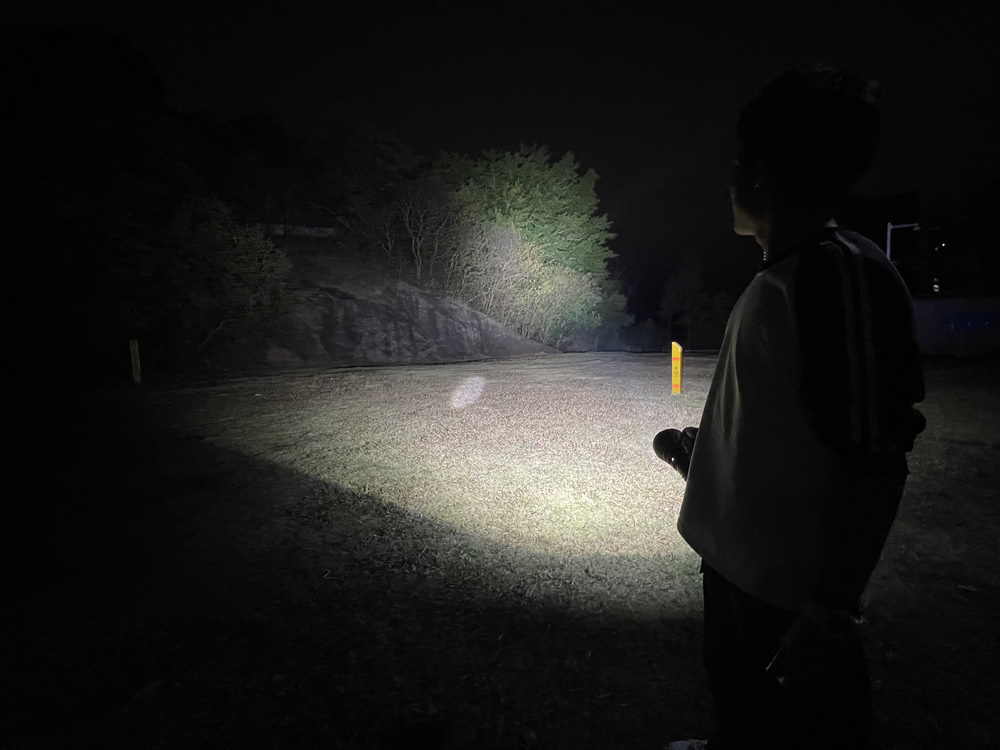The Brightness Breakdown: Understanding 300lm, 1000lm, and 5000lm Flashlight Segments

Imagine you need a reliable flashlight for late-night repairs, a camping trip, or an emergency power outage. Your choice of lumens, battery life, and performance can affect visibility, illumination, and safety. Studies show matching flashlight brightness to your environment improves satisfaction and protection. Whether you need a helius flashlight for demanding situations or an everyday led model, understanding features like led bulbs, battery life, and durability matters. Flashlight uses and applications depend on illumination, runtime, and led performance. Selecting the right light ensures optimal visibility and reliable performance for all flashlight applications.
Key Takeaways
Lumens measure the brightness of a flashlight. Higher lumens mean brighter light, but consider the beam type for effective illumination.
A 300 lumens flashlight is ideal for everyday indoor tasks. It provides enough light for reading, repairs, and emergencies without being overwhelming.
For outdoor activities like camping, a 1000 lumens flashlight offers a strong beam that enhances safety and visibility in low-light conditions.
In demanding situations, such as search and rescue, a 5000 lumens flashlight is essential. It illuminates large areas and helps navigate through obstacles.
Always match the flashlight's lumens and features to your specific needs. Consider the environment, battery life, and durability for optimal performance.
Lumens and Flashlight Brightness
What Are Lumens?
When you choose a flashlight, you often see the term lumens on the packaging. Lumens measure the total amount of visible light a flashlight emits. This unit helps you compare the brightness levels of different models. You can think of lumens as a way to quantify how much light you get from your flashlight.
Here is a simple table to help you understand the scientific definition and measurement of lumens:
Definition | Description |
|---|---|
Lumen | A unit of luminance representing the total amount of visible light emitted by a flashlight's bulb or LED. |
Measurement | A single lumen is produced by photons escaping a one-foot square hole in a light-proof sphere with a standardized 'candle' inside. |
You use lumens to compare the luminous flux, which is the perceived power of visible light. The lumen value is standardized internationally, so you can trust the numbers when you shop for a flashlight. One lumen equals one candela-steradian, which means it is a precise measurement of light output.
The lumen is an international standardized measurement unit for total light emitted by a light source.
It quantifies luminous flux, which is the perceived power of visible light emitted by a source.
The lumen is defined as equivalent to one candela-steradian.
How Lumens Affect Brightness
Lumens directly influence the brightness of your flashlight. A higher lumen value usually means a brighter flashlight, but the way the light is distributed also matters. You might notice that some flashlights with high lumens do not always appear brighter if they spread the light over a wide area.
Flashlights with more lumens generally appear brighter.
Floodlight beams spread light widely, resulting in softer brightness even with high lumens.
Spotlight beams focus light into a narrow area, making them seem brighter even with fewer lumens.
The distance your flashlight can reach depends on both the lumen value and the beam type.
When you select a flashlight, consider how you will use it. If you need to illuminate a large area, choose a model with a floodlight beam and higher lumens. For tasks that require focused brightness, a spotlight beam with moderate lumens may work better. Understanding lumens helps you pick the right flashlight for your needs and ensures you get the brightness levels you expect.
Tip: Always check both the lumen value and the beam type when comparing flashlights. This helps you match the brightness and light distribution to your specific situation.
How Bright is 300 Lumens?

Everyday Uses
You may wonder how bright is 300 lumens when you pick up a flashlight for everyday tasks. A 300 lumens flashlight offers a level of brightness that fits most indoor needs. You can use it to find items in a dark closet, check under furniture, or light up a hallway during a power outage. Many people rely on this brightness for reading in bed, working on small repairs, or walking the dog at night.
When you compare how bright is 300 lumens to typical indoor lighting, you see that it matches or exceeds the light in many rooms. The table below shows how a 300 lumens flashlight stacks up against common indoor lighting:
Lighting Type | Lumens Range | Description |
|---|---|---|
Typical Indoor | 100-800 lumens | Moderate lighting for small rooms like bedrooms. |
300 Lumen Flashlight | 300 lumens | Suitable for moderate illumination indoors/outdoors. |
You get enough light for most everyday tasks without overwhelming your eyes. The focused beam of a flashlight also helps you direct light exactly where you need it, making it more efficient than overhead lights for certain jobs.
Pros and Cons
A 300 lumens flashlight brings several advantages for home and indoor use. You benefit from durable construction and a long runtime, which means you can rely on your flashlight during extended use. The practical beam distance covers most rooms, and the simple single-button operation makes it easy for anyone to use.
However, you should consider a few drawbacks. Some 300 lumens flashlights use D-cell batteries, which can make them heavy and large. If the batteries become damaged, you may notice flickering. The table below summarizes the main pros and cons:
Advantages | Disadvantages |
|---|---|
Durable construction | Heavy and large due to D-cell batteries |
Long runtime | May flicker if batteries are damaged |
Practical beam distance | |
Easy operation with a single button |
For most everyday tasks, a 300 lumens flashlight gives you the right balance of brightness and usability. You can trust it for home projects, quick outdoor checks, or as a backup during emergencies. If you need more power for demanding situations, you might consider a helius flashlight or a higher-lumen model, but for daily use, 300 lumens often proves ideal.
1000lm Flashlight for Outdoors

Camping and Hiking
When you prepare for outdoor adventures, a 1000lm flashlight becomes an essential tool. You need enough brightness to navigate trails, set up camp, or locate gear in the dark. The 1000 lumens output provides a strong beam that reaches far beyond what a basic model offers. You can rely on this level of light for hiking after sunset or exploring unfamiliar terrain. Many campers choose a flashlight with 1000 lumens because it balances power and portability. You get a beam that cuts through fog and illuminates wide areas, making your outdoor experience safer and more enjoyable.
A reliable flashlight with 1000 lumens helps you avoid hazards and find your way in low-light conditions. You can use it to signal for help or check your surroundings for wildlife. The focused brightness ensures you see obstacles clearly, even when the environment changes quickly. If you need a backup for emergencies, a helius flashlight with high lumens output can serve as a dependable option.
Balance of Brightness and Runtime
You must consider how long your flashlight will last on a single battery charge. The balance between brightness and battery life is crucial for outdoor use. A flashlight with 1000 lumens often features advanced battery management to extend runtime. For example, the Klarus XT1A flashlight delivers over one hour of high output before stepping down to about 40% brightness. This design helps you conserve battery power while maintaining useful light.
Lower lumen flashlights offer longer battery life but less brightness.
1000 lumens models provide a good mix of brightness and runtime for most outdoor needs.
High-lumen flashlights may not sustain maximum brightness for long due to battery and heat limitations.
You should choose a flashlight that matches your activity. If you plan a long hike, select a model with efficient battery use and consistent light output. For short tasks, a powerful beam with 1000 lumens gives you the visibility you need. Always check the battery type and capacity before heading outdoors. Rechargeable batteries offer convenience, while disposable options may last longer in cold weather. A reliable flashlight ensures you have enough light for every situation.
Flashlight Type | Lumens | Typical Runtime | Best Use Case |
|---|---|---|---|
Everyday Model | 300 lumens | 3-6 hours | Home, indoor tasks |
Outdoor Model | 1000 lumens | 1+ hour | Camping, hiking |
High-Performance | 5000 lumens | <1 hour | Search, rescue |
Tip: Always carry spare batteries or a backup flashlight when you explore outdoors. You never want to run out of light in critical moments.
5000lm Flashlight for Demanding Situations
Search and Rescue
You face unique challenges during search and rescue operations. Low visibility conditions demand a reliable flashlight with intense brightness. Professional guidelines recommend a flashlight with at least 1,000 to 2,000 lumens, but a high lumen flashlight with 5000 lumens gives you a clear advantage. You can illuminate large areas, making it easier to locate missing persons or objects. The powerful light output helps you navigate debris, dense woods, or collapsed structures. You need a flashlight that offers strobe or SOS modes to signal for help in emergencies. These features increase your safety and improve your chances of a successful rescue.
A 5000 lumens flashlight covers wide spaces, reducing blind spots.
You can use the bright light to scan fields, buildings, or water surfaces.
Strobe and SOS modes help you attract attention during emergencies.
You rely on a flashlight with long battery life to avoid interruptions.
You must select a flashlight that withstands harsh environments. The battery should last through extended operations, and the light must remain steady. You need a model that performs well in rain, dust, or extreme temperatures.
Professional Use
You encounter demanding situations in your work as a first responder, security officer, or outdoor guide. A reliable flashlight with 5000 lumens provides the brightness you need for tactical situations, inspections, or emergencies. The helius flashlight stands out among high-brightness models. Experts praise its robust design, waterproof capability, and impact resistance. You benefit from advanced LEDs that save battery power while delivering intense light. The helius flashlight offers multiple lighting modes, including long-range illumination for outdoor adventures and emergencies.
The helius flashlight delivers consistent performance in low visibility conditions.
You trust its construction and battery efficiency for search and rescue or tactical situations.
Users report reliable flashlight operation during emergencies and outdoor activities.
You should choose a flashlight that matches your professional needs. Look for features like durable housing, energy-saving LEDs, and long battery life. A high lumen flashlight ensures you have the light required for search and rescue, emergencies, and other critical tasks.
Tip: Always test your flashlight before heading into demanding environments. Confirm the battery is fully charged and the light modes function properly.
Comparing Flashlight Segments
Quick Comparison Table
You need to compare flashlight segments before making a decision. Each segment offers unique advantages in lumens, brightness, battery life, and durability. The following table summarizes the key differences among 300lm, 1000lm, and 5000lm flashlights:
Lumen Output | Beam Distance | Battery Life | Ideal Uses | Durability (IP Rating) | Weight |
|---|---|---|---|---|---|
300lm | 50–100 meters | Long (8–20 hrs) | Home, reading, small repairs | IPX4–IP65 | Lightest |
1000lm | 100–200 meters | Moderate (2–8 hrs) | Camping, hiking, law enforcement | IP65–IP67 | Moderate |
5000lm | 200+ meters | Short (1–3 hrs) | Search & rescue, emergencies, military | IPX6–IPX8 | Heaviest |
You see that a flashlight with 300 lumens gives you extended battery life and lightweight design. This segment works best for indoor use and small tasks. A 1000 lumens flashlight provides a balance between brightness and battery performance, making it ideal for outdoor activities. If you need maximum brightness, a 5000 lumens flashlight delivers intense light for demanding situations, but you sacrifice battery life and portability.
Environmental conditions also affect flashlight performance. Fog scatters light and reduces beam distance, so you should use a low-intensity, wide flood beam. Rain shortens range, but a waterproof flashlight with medium throw remains effective. Snow creates glare and reduces contrast, so a warmer color temperature flashlight works better.
Weather Condition | Impact on Beam Distance | Visibility Effect | Best Flashlight Type |
|---|---|---|---|
Fog | Beam scatters | “Light wall” effect | Low-intensity, wide flood beam |
Rain | Shorter range | Usable, some reflection | Waterproof flashlight with medium throw |
Snow | Reduced distance | Loss of contrast | Warmer color temperature flashlight |
You must consider durability when choosing a flashlight. IP ratings indicate how well a flashlight resists water and dust. For general outdoor use, IP65 or IPX4 ratings protect against rain and splashes. If you expect heavy rain or submersion, select a flashlight with IP67, IPX7, or IPX8 ratings.
IP Rating | Description |
|---|---|
IP65 | Dustproof, resists light water spray, suitable for moderate weather |
IP67 | Dustproof, handles submersion up to 1 meter for 30 minutes |
IPX4 | Protects against water splashes |
IPX6 | Resists high-pressure water jets |
IPX7 | Protects against immersion up to 1 meter |
IPX8 | Suitable for deeper water immersion |
Battery options also impact flashlight performance. Rechargeable batteries offer convenience and cost savings. Disposable batteries last longer in cold weather and provide reliability in emergencies. Some flashlights feature dual fuel technology, allowing you to use both types for greater versatility.
Feature | Impact on Performance |
|---|---|
Lumens | Higher lumens improve brightness and usability in low-light situations |
Dual Fuel Technology | Rechargeable and disposable batteries enhance versatility and reliability |
Choosing the Right Flashlight
You must match the flashlight's lumens and brightness to your specific needs. If you use a flashlight for home tasks, select a model with less than 400 lumens. For camping or law enforcement, choose a flashlight with 400 to 1000 lumens. Advanced camping, military, or rescue work requires 1000 to 3000 lumens. If you work in extreme conditions, such as firefighting or search and rescue, a flashlight with 3000 to 7000 lumens, like the helius flashlight, provides the necessary brightness.
Lumen Range | Ideal Uses |
|---|---|
<400 | Home-use, reading, small repairs |
400–1000 | Law enforcement, construction, camping |
1000–3000 | Military, search and rescue, advanced camping |
3000–7000 | Military, firefighters, rescue squads |
You should avoid common mistakes when selecting a flashlight:
Overemphasizing peak lumens without considering beam quality.
Ignoring battery runtime specifications.
Failing to match the flashlight's brightness to its intended use.
You need to evaluate the environment where you will use the flashlight. Fog, rain, and snow can reduce visibility and scatter light. In these conditions, a flashlight with higher lumens may help, but beam type and color temperature also matter. You should check the flashlight's IP rating to ensure durability in harsh weather.
Tip: Always test your flashlight before heading out. Confirm battery charge, inspect the beam, and check all light modes. Carry spare batteries or a backup flashlight for emergencies.
You must consider weight and portability. A 300 lumens flashlight is light and easy to carry. A 1000 lumens flashlight balances brightness and weight. A 5000 lumens flashlight is heavier but delivers maximum brightness for critical tasks.
You should choose a flashlight that fits your activity, environment, and runtime needs. Select the right lumens, battery type, and durability features to ensure reliable performance. You gain confidence and safety when you match your flashlight to your requirements.
You see clear differences in flashlight segments.
300lm flashlights work best for close-range tasks and everyday carry.
1000lm flashlights suit tactical use, hunting, and law enforcement, offering powerful brightness and multiple modes.
5000lm flashlights excel in extreme conditions where maximum brightness is essential.
Consider your environment and needs before selecting a flashlight.
Household tasks need a flashlight with lower lumens.
Outdoor activities require a flashlight with higher output.
Specialized situations demand a flashlight with maximum brightness.
Share your flashlight experiences or questions below. Your feedback helps others choose the right flashlight.
FAQ
What does the lumen rating mean for a flashlight?
The lumen rating tells you how much visible light a flashlight produces. Higher lumens give you brighter light. You should check the lumen rating before buying a flashlight for any activity.
How do I choose the right flashlight for camping?
You need a flashlight with at least 1000 lumens for camping. This brightness helps you see trails and campsites. Look for a flashlight with good battery life and weather resistance.
Can a 300 lumens flashlight work for emergencies?
A 300 lumens flashlight works well for most indoor emergencies. You get enough brightness to move safely. For outdoor emergencies, you may want a flashlight with higher lumens.
What features should I look for in a professional flashlight?
You should choose a flashlight with high lumens, durable construction, and multiple modes. Waterproof ratings and long battery life also matter. Professionals often use a flashlight with advanced LED technology.
How do weather conditions affect flashlight performance?
Rain, fog, and snow can reduce the beam distance of your flashlight. You should select a flashlight with a strong beam and proper IP rating for harsh weather. Warmer color temperature helps in snowy conditions.
See Also
A Detailed Guide to Understanding Flashlight Lumens
Exploring 1000 Lumens: Understanding Brightness in Lighting
Exploring Stepless Dimming Features in Modern Flashlights
